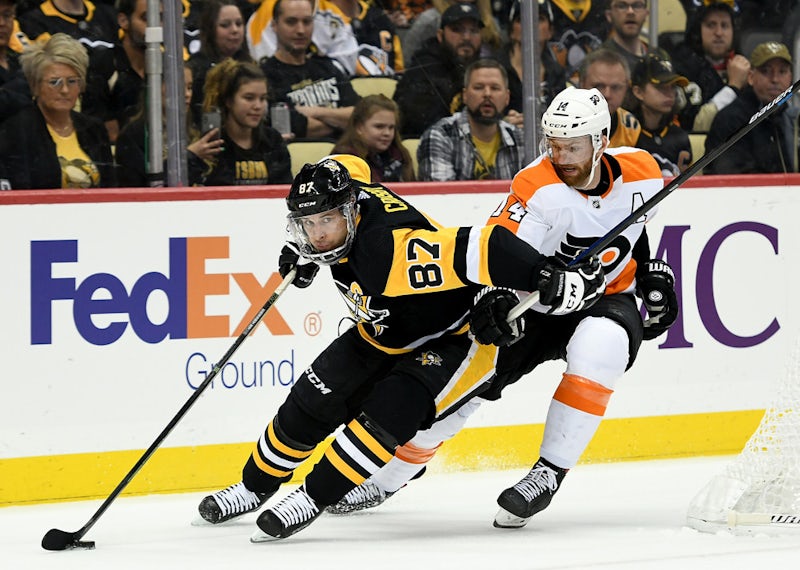ADVERTISEMENT
The bettor's guide to hockey analytics

Pittsburgh Penguins forward Sidney Crosby (left) controls the puck. (Photo by Justin Berl/Icon Sportswire)
Like so many sports across the globe, the way hockey is analyzed has undergone a massive transformation in recent years.
The days of putting significant stock into statistics like plus-minus — the difference in the number of five-on-five goals for and goals against a player was on the ice for — have given way to a new and evolving set of analytics, designed to dig deeper into a player’s individual impact or a team’s success.
The new analytics can also be beneficial from the perspective of a sports bettor. With the NHL planning a return to action for the end of July, let’s take a look at some of the new metrics.
Corsi For/Corsi Against
Among the most well-known measures in hockey’s analytical world is Corsi For and Corsi Against. It measures the number of total shot attempts — shots on goal, missed attempts, and shots blocked — for a player or team, as well as the number of total shot attempts given up.
It can be measured in total numbers, a plus-minus differential, or percentage rates, and it is applicable for players and teams at five-on-five play, as well as on special teams. It is just one tool that can help indicate puck possession, which can be a strong factor for determining a team’s overall success.
Shooting percentage
Shooting percentage is calculated by taking the number of total goals scored by a player or team and dividing it by the number of shots taken. Alex Killorn of the Tampa Bay Lightning has the best shooting percentage in the NHL this season, among players who have played in more than 30 games. He has scored 26 goals on 130 shots on goal, a 20% rate.
Shooting percentage rates for a player will have an impact on their goal and point production, and can be subject to fluctuation over the course of a season, as players and teams go through hot or cold streaks.
PDO
PDO is calculated as a sum of a team’s five-on-five shooting percentage and five-on-five save percentage. It is often described as an analytics tool that is used to indicate a team or player’s luck and the possibility of regression toward the mean.
The Tampa Bay Lightning had the highest PDO in the league this season, at 102.6 at five-on-five, with an above-average shooting percentage of 11.8, which helped boost their overall PDO.
🚀🚀🚀 Steven Stamkos from his office is automatic 🚀🚀🚀 pic.twitter.com/a2xnQY2QAq
— Sportsnet (@Sportsnet) November 15, 2019
Goals/assists/points per 60 minutes
These are calculated as rate of goals, assists, or points per 60 minutes of play.
Alex Ovechkin and Auston Matthews, two of the best goal scorers in the NHL, averaged 1.65 and 1.55 goals per 60 minutes, respectively, for the 2019-2020 season. Evgeni Malkin of the Pittsburgh Penguins leads the league with 2.24 assists per 60 minutes.
Alex Ovechkin scores his 700th career NHL goal pic.twitter.com/dU9aMpKeWr
— Brady Trettenero (@BradyTrett) February 22, 2020
Expected goals for/against
Corsi For and Against only tells part of the story related to the quality of a team’s offensive attack. While an indicator of puck possession based on total shot attempts, it doesn’t factor in the quality of those shot attempts as a true threat to score. That’s where expected goals comes in.
Expected goals takes all unblocked shot attempts and, according to The Athletic, assigns a quality to that shot on the likelihood of it will result in a goal.
High-danger scoring chances
WAR on Ice, once one of the premier sites for hockey analytics information, has defined scoring chances as a shot attempt taken from an area on the ice where goals are expected to be scored from.
Those shot attempts are given a value of 1, 2, or 3, according to Hockey Reference. A scoring chance with a rating of 3 or better is called a high-danger scoring chance.
Brendan Gallagher of the Montreal Canadiens led the NHL with a high-danger scoring chance rate of 63.9%, for players with more than 300 minutes played this season. That is the percentage of total high-danger scoring chances while that player is on the ice for his team.
Goals saved above average
Into the goaltending metrics we go! Analytics experts have suggested goals saved above average is one of the most accurate methods to measure a goalie’s performance.
It is, according to Hockey Reference, the number of goals prevented, based on save percentage and shots faced versus the league average save percentage on the same number of shots.
Tuukka Rask of the Boston Bruins has the league’s best GSAA this season, at 22.51.
On this day in 2006, the #Leafs traded Tuukka Rask to the #NHLBruins for Andrew Raycroft. Rask has recorded 291 career wins in the NHL, the most ever by a goaltender drafted by the Maple Leafs. pic.twitter.com/BFaeJnzKpT
— Sportsnet Stats (@SNstats) June 24, 2020
Meanwhile, the Bruins gave up a league-best 2.39 goals against per game, and will play in the round-robin portion of the NHL's return-to-play plan next month.
Place a wager of $5 or more with BetAmerica and get $20 in free bets!
ADVERTISEMENT